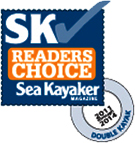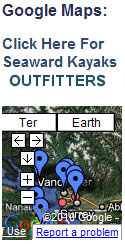True to Tradition:
Seaward Kayaks has designed and handcrafted our kayaks right here in North America for over twenty five years. Despite many changes in the industry since then our primary focus has stayed the same: build the strongest and safest kayaks available.
The big buzz in the paddlesports industry today is light weight kayaks. But in order to save weight and build an ultra light kayak something has to give. Primarily it’s materials and this can result in a less durable kayak.
Seaward performs repairs to all makes and models of kayaks. This allows us to examine many different build procedures and evaluate the structural integrity of different kayaks. Here are some points to consider when purchasing your next kayak:
* Saving a couple pounds helps when getting your kayak from the car to the water. However, when you hit something in the water is that weight saving going to put you in danger?
* light weight kayaks are normally built over seas. After sales service can sometimes be a concern. People have gone back to the dealer they purchased the kayak from to find out there was nothing that could be done to help them. This is buy no means a fault with the dealer.
* Due to the lower quality materials and resins used to produce these kayaks it’s hard to provide a color match for the damaged area.
* Last year a number of kayaks came through our facility for repairs from one large manufacturer. Marketed as one of the lightest in the industry the lay up in these popular kayaks was so poor they were cracking on people’s roof racks - we could actually crack the kayak by lightly hitting the deck or hull with our hand! This example demonstrates that the never ending quest to build the lightest kayak is jeopardising kayak quality. And potentially paddler safety.
* Weigh the kayak you yourself. A common marketing tool is for manufactures to post the kayak weight prior to adding the seat, rudder, hatches and rigging. Be careful of this one!
We often hear from paddlers who wished they had spent more on their initial investment, and are now forced to spend hundreds of dollars on a repair that shouldn’t be required.
When designing our new SR Super Rec series of kayaks last year Seaward had input regarding weight and what paddlers were looking for. Before building the kayaks we took all the required materials and weighed them. We then looked at each individual component to see whether it could reasonably be removed from the kayak. But we did nothing that would jeopardize the durability and safety of the product or paddler.
If you are considering a new kayak this season consider these points:
1. Will my investment keep me safe in the conditions that I am going to be paddling?
2. If something happens to my kayak do I have someone/somewhere to turn for assistance?
3. What form of conditions am I going to be paddling in?
4. Is the kayak that I am considering going to last for many seasons to come?
5. Where is my potential new kayak manufactured?
The only time weight is really an issue is when off-loading the kayak.
In actuality a little extra weight is a good thing in the water – it aids momentum and allows the kayak to better ‘hold its line’ on the water or in strong waves & currents.
You can stand and sit on the deck of a Seaward Composite Kayak. What does this mean for the customer? Well, durability for the life of the kayak for one. But also a safe kayak you can depend on in tough conditions & everyday use.
A Seaward can be used to perform rescues, be it T-rescue, paddle float or rolls, continually – year after year. We have Tour operators with fifteen year old Seawards in their fleet still going strong!
Our manufacturing process may be ‘old school’ but the results are real. Our highly skilled builders are adamant that our hand laid up process results in a consistently higher quality and stronger kayak. Otherwise we’d do it differently!



